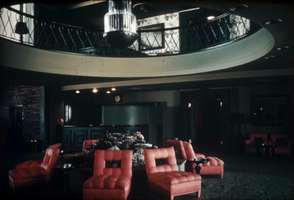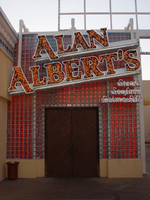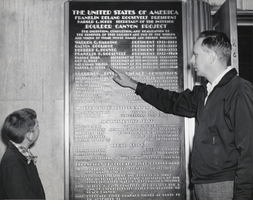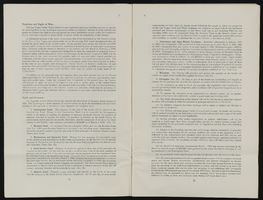Search the Special Collections and Archives Portal
Search Results

Slide of the Flamingo Hotel, Las Vegas, circa 1950s
Date
1950 to 1959
Archival Collection
Description
The Flamingo Hotel located in Las Vegas, Nevada. The inner lobby consists of two floors and multiple red lounging chairs.
Image

Slide of the Flamingo Hotel, Las Vegas, circa 1950s
Date
1950 to 1959
Archival Collection
Description
The inside bar and lounge located within the Flamingo Hotel in Las Vegas, Nevada. Red barstools can be seen lining the bar, along with other lounge chairs scattered about the establishment.
Image

Film transparency of the mountains near Virginia City, Nevada, circa 1940s
Date
1940 to 1949
Archival Collection
Description
The mountains near Virginia City, Nevada. Virga can be seen falling from the clouds. Like many cities and towns in Nevada, Virginia City was a mining boomtown; it developed virtually overnight as a result of miners rushing to the Comstock Lode silver strike of 1859 on the eastern slopes of Mount Davidson. But, Virginia City far surpassed all others for its peak of population, technological advancements developed there, and for providing the population base upon which Nevada qualified for statehood. The riches of the Comstock Lode inspired men to hunt for silver mines throughout Nevada and other parts of the American West. At its peak, Virginia City had a population of over 25,000 residents and was called the richest city in America. Dominated by San Francisco moneyed interests, Virginia City was heralded as the sophisticated interior partner of San Francisco. “San Francisco on the coast and Virginia City inland” became the mantra of west coast Victorian entrepreneurs. Early Virginia City settlers were in large part the backwash from San Francisco and the California Gold Rush, ten years before. Mine owners who made a killing in the Comstock mines spent most of their wealth in San Francisco.
Image

Photographs of Alan Albert's signs, Las Vegas (Nev.), 2002
Date
2002
Archival Collection
Description
Daytime and nighttime views of the Alan Albert's restaurant signs on the Strip. Information about the sign is available in the Southern Nevada Neon Survey Data Sheet.
Site address: 3763 S Las Vegas Blvd
Sign details: Following the alleyway created between the Walgreen's and Fatburger establishments, you can find the entrance to the secluded Alan Albert's. The restaurant is located on the Fatburger (north) side of the drive, found headed east down the south side of the building. The building quickly stretches out to the south and then continues east again. Signage is located on this extension of wall. The signage includes a logo wall sign, a neon back-lit glass block wall, as well as three small steel boxes adorned with crafted neon. Signage is also located on the Walgreen's dominated pylon out front.
Sign condition: Structure 5 Surface 4 Lighting 5 Note:The structure of the sign is intact, and appears to be complete in all its parts. The surface of the sign is worn by the weather, but no worse than any other property.
Sign form: Fascia
Sign-specific description: The small face created by the south extension creates the space for the entrance to Alan Albert's. The sign hangs off this wall above a pair of large wooden doors, created with brown painted channel letters in a text specific to the establishment. They are painted white on the exterior. The channel letters are steel, outlined with white neon and filled with incandescent bulbs. White neon tubes underline each word. Almost the entire wall is created of translucent glass blocks. Behind the glass blocks there are tubes of red neon running vertically and horizontally along the open sections of the blocks create a glowing background grid of red light. The entire sign is supported with steel brackets, which are hung from the top of the roof hooking onto the wall of the building. The letters are hung at an angle pointing from the bottom toward the top right hand corner of the building. Below the main text on the right hand portion of the sign are three horizontal steel boxes hung consecutively, supporting text sculpted out of neon. The top box reads "Steaks," the second reads "Seafood," and the third reads "Prime-rib." On the Multi-use pylon the Alan Albert's signage only plays second fiddle to the dominant Walgreen's sign. It is four lines of text with the two lines of "Alan Albert's" filling the top spots. Below that "steaks, seafood, prime rib," sits above the text "so delicious intimate." The top two lines are spelled in brown channel letters, filled with incandescent bulbs, and bordered on the face with red neon. A narrow polished channel underlines each line of text and is lined with a single tube of white neon. The bottom two lines of text are smaller script channel letters lined with red neon. Below this collection of letters and bulbs, a backlit selection of signs also adds to the list. "Lobster House" is spelled in closed channel letters with red faces. A narrow internally lit green cabinet, with rounded ends, is treated with white script.
Sign - type of display: Neon; Incandescent; Backlit
Sign - media: Steel; Plastic; Glass
Sign - non-neon treatments: Graphics; Paint
Sign animation: Oscillating
Notes: The incandescent bulbs inside the interior of the main text, oscillate rapidly. The effect is the shimmering effect seen so often throughout neighboring properties. It can be seen in the main building texts of properties such as the Monte Carlo and the Mirage. The Alan Albert's text on the Walgreen's pylon near the street is animated as well. The incandescent bulbs animate with an oscillating pattern steady burn on, then flash off, then on, off then starts to oscillate once again.
Sign environment: Alan Albert's sits tucked away from the bustle of the main street, guarded on both sided by Walgreen's and the Fatburger establishments. Besides the adjacent archway advertising for the Ginseng BBQ establishment, the signage for the Alan Albert's is the main attraction in the immediate space.
Sign manufacturer: YESCO
Sign - artistic significance: The significance of the Alan Albert's establishment fits in with other facilities on the Strip such as The Rosewood Grill, and Battista's Hole in the Wall, and the Peppermill. Considering that most dining establishments are located on the interior of the properties, these stand as excellent quality, intimate restaurants seen by and available to the pedestrian public. Like the everyday establishments dressed to fit in the Las Vegas Strip such as the neighboring Walgreen's, Alan Albert's is a non-casino dressed up to fit in with the local surroundings. The incandescent bulbs also contain the most common animation seen on the strip. The surface of the wall is turned into a blurry illuminated canvas with glass block wall, backed by a grid of red neon. The surface is a one of a kind for the properties in this survey and the genre that it represents.
Surveyor: Joshua Cannaday
Survey - date completed: 2002
Sign keywords: Oscillating; Neon; Incandescent; Backlit; Paint; Graphics; Steel; Plastic; Glass; Fascia
Site address: 3763 S Las Vegas Blvd
Sign details: Following the alleyway created between the Walgreen's and Fatburger establishments, you can find the entrance to the secluded Alan Albert's. The restaurant is located on the Fatburger (north) side of the drive, found headed east down the south side of the building. The building quickly stretches out to the south and then continues east again. Signage is located on this extension of wall. The signage includes a logo wall sign, a neon back-lit glass block wall, as well as three small steel boxes adorned with crafted neon. Signage is also located on the Walgreen's dominated pylon out front.
Sign condition: Structure 5 Surface 4 Lighting 5 Note:The structure of the sign is intact, and appears to be complete in all its parts. The surface of the sign is worn by the weather, but no worse than any other property.
Sign form: Fascia
Sign-specific description: The small face created by the south extension creates the space for the entrance to Alan Albert's. The sign hangs off this wall above a pair of large wooden doors, created with brown painted channel letters in a text specific to the establishment. They are painted white on the exterior. The channel letters are steel, outlined with white neon and filled with incandescent bulbs. White neon tubes underline each word. Almost the entire wall is created of translucent glass blocks. Behind the glass blocks there are tubes of red neon running vertically and horizontally along the open sections of the blocks create a glowing background grid of red light. The entire sign is supported with steel brackets, which are hung from the top of the roof hooking onto the wall of the building. The letters are hung at an angle pointing from the bottom toward the top right hand corner of the building. Below the main text on the right hand portion of the sign are three horizontal steel boxes hung consecutively, supporting text sculpted out of neon. The top box reads "Steaks," the second reads "Seafood," and the third reads "Prime-rib." On the Multi-use pylon the Alan Albert's signage only plays second fiddle to the dominant Walgreen's sign. It is four lines of text with the two lines of "Alan Albert's" filling the top spots. Below that "steaks, seafood, prime rib," sits above the text "so delicious intimate." The top two lines are spelled in brown channel letters, filled with incandescent bulbs, and bordered on the face with red neon. A narrow polished channel underlines each line of text and is lined with a single tube of white neon. The bottom two lines of text are smaller script channel letters lined with red neon. Below this collection of letters and bulbs, a backlit selection of signs also adds to the list. "Lobster House" is spelled in closed channel letters with red faces. A narrow internally lit green cabinet, with rounded ends, is treated with white script.
Sign - type of display: Neon; Incandescent; Backlit
Sign - media: Steel; Plastic; Glass
Sign - non-neon treatments: Graphics; Paint
Sign animation: Oscillating
Notes: The incandescent bulbs inside the interior of the main text, oscillate rapidly. The effect is the shimmering effect seen so often throughout neighboring properties. It can be seen in the main building texts of properties such as the Monte Carlo and the Mirage. The Alan Albert's text on the Walgreen's pylon near the street is animated as well. The incandescent bulbs animate with an oscillating pattern steady burn on, then flash off, then on, off then starts to oscillate once again.
Sign environment: Alan Albert's sits tucked away from the bustle of the main street, guarded on both sided by Walgreen's and the Fatburger establishments. Besides the adjacent archway advertising for the Ginseng BBQ establishment, the signage for the Alan Albert's is the main attraction in the immediate space.
Sign manufacturer: YESCO
Sign - artistic significance: The significance of the Alan Albert's establishment fits in with other facilities on the Strip such as The Rosewood Grill, and Battista's Hole in the Wall, and the Peppermill. Considering that most dining establishments are located on the interior of the properties, these stand as excellent quality, intimate restaurants seen by and available to the pedestrian public. Like the everyday establishments dressed to fit in the Las Vegas Strip such as the neighboring Walgreen's, Alan Albert's is a non-casino dressed up to fit in with the local surroundings. The incandescent bulbs also contain the most common animation seen on the strip. The surface of the wall is turned into a blurry illuminated canvas with glass block wall, backed by a grid of red neon. The surface is a one of a kind for the properties in this survey and the genre that it represents.
Surveyor: Joshua Cannaday
Survey - date completed: 2002
Sign keywords: Oscillating; Neon; Incandescent; Backlit; Paint; Graphics; Steel; Plastic; Glass; Fascia
Mixed Content

Photograph of Ray Lyman Wilbur II and Ray Lyman Wilbur III, Hoover Dam, circa 1950s
Date
1950 to 1959
Archival Collection
Description
The caption on the back of the image reads, " "Like grandfather, like father, like son" is an appropriate title for this photograph of Ray Lyman Wilbur II and Ray Lyman Wilbur III, reading the name of Ray Lyman Wilbur I on a bronze plaque at the Hoover Dam. As noted on the plaque, Ray Lyman Wilbur I was secretary of the Interior during President Hoover's administration and played a major role in administrative matters pertaining to the construction of Hoover Dam. His son and grandson, shown here, were visitors to the dam recently and were given a specially-conducted tour by the Bureau of Reclamation's guide service. The father and son reside at 1808 Indiana Street, Vallejo, California. The plaque is on the left hand side of the entrance to the Hoover Dam's Arizona elevator tower through which a third of a million visitors leave the dam and power plant each year following guided tours of this mammoth structure on the Colorado River between Nevada and Arizona. Guided tours of the dam and power plant, starting at the elevator tower on the Nevada side, are available daily to the public between the hours of 8 a.m. to 5 p.m. Ca. 1950's (Bureau of Reclamation photo)."
Image

Proposal for a future look to downtown Las Vegas: 1984 and beyond, March 2, 1984
Date
1984
Description
A master development plan for the city of Las Vegas from 1984.
Image
Pagination
Refine my results
Content Type
Creator or Contributor
Subject
Archival Collection
Digital Project
Resource Type
Year
Material Type
Place
Language
Records Classification


